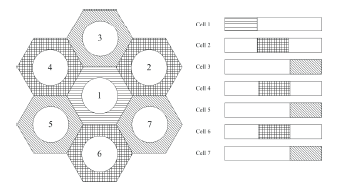TR2008-083
Adaptive Soft Frequency Reuse for Inter-Cell Interference Coordination in SC-FDMA Based 3GPP LTE Uplinks
-
- , "Adaptive Soft Frequency Reuse for Inter-cell Interference Coordination in SC-FDMA based 3GPP LTE Uplinks", IEEE Global Telecommunications Conference (GLOBECOM), November 2008, pp. 1-6.BibTeX TR2008-083 PDF
- @inproceedings{Mao2008nov,
- author = {Mao, X. and Maaref, A. and Teo, K.H.},
- title = {{Adaptive Soft Frequency Reuse for Inter-cell Interference Coordination in SC-FDMA based 3GPP LTE Uplinks}},
- booktitle = {IEEE Global Telecommunications Conference (GLOBECOM)},
- year = 2008,
- pages = {1--6},
- month = nov,
- issn = {1930-529X},
- url = {https://www.merl.com/publications/TR2008-083}
- }
- , "Adaptive Soft Frequency Reuse for Inter-cell Interference Coordination in SC-FDMA based 3GPP LTE Uplinks", IEEE Global Telecommunications Conference (GLOBECOM), November 2008, pp. 1-6.
-
Research Area:

Abstract:
This paper proposes a decentralized adaptive soft frequency reuse scheme for the uplink of a 4G long-term evolution (LTE) system. While universal frequencies reuse (UFR) is being targeted for next generation multi-cellular wireless networks, ongoing efforts supporting the LTE standard have proved that actual implementations of UFR in LTE lead to unacceptable interference levels experienced by user equipments near the cell edge area in a multi-cellular configuration. The herein proposed adaptive soft frequency reuse scheme is a step forward towards effective inter-cell interference coordination (ICIC) in next-generation wireless networks. Our solution to the uplink ICIC problem stands out for its two essential features that consist of physical resources block (PRB) reuse avoidance/minimization and cell-edge bandwidth breathing which can be implemented at the cost of a negligible information exchange over the X2 interference (backbone). The PRB reuse avoidance feature significantly decreases inter-cell interference levels while improving the achievable average throughput per user, especially for those identified as cell-edge ones. The cell-edge bandwidth breathing strategy allows to track and adapt to semi-static changes in traffic loading and user distributions within each cell which drastically reduces the blocking probability of incoming calls under cell-edge bandwidth constrained traffic.
Related News & Events
-
NEWS GLOBECOM 2008: 6 publications by Koon Hoo Teo, Matthew Brand, Amine Maaref, Jinyun Zhang, Matthew E. Brand and Zafer Sahinoglu Date: November 30, 2008
Where: IEEE Global Telecommunications Conference (GLOBECOM)
MERL Contacts: Matthew Brand; Jinyun ZhangBrief- The papers "Routing with Probabilistic Delay Guarantees in Wireless Ad-Hoc Networks" by Brand, M., Maymounkov, P. and Molisch, A.F., "Delay-Energy Tradeoffs in Wireless Ad-Hoc Networks with Partial Channel State Information" by Brand, M. and Molisch, A.F., "Low-Complexity Hybrid QRD-MCMC MIMO Detection" by Peng, R., Teo, K.H., Zhang, J. and Chen, R.-R., "Adaptive Soft Frequency Reuse for Inter-cell Interference Coordination in SC-FDMA based 3GPP LTE Uplinks" by Mao, X., Maaref, A. and Teo, K.H., "Impact of Mobility on the Behavior of Interference in Cellular Wireless Networks" by Yarkan, S., Maaref, A. and Teo, K.H. and "Modified Beacon-Enabled IEEE 802.15.4 MAC for Lower Latency" by Bhatti, G., Mehta, A., Sahinoglu, Z., Zhang, J. and Viswanathan, R. were presented at the IEEE Global Telecommunications Conference (GLOBECOM).